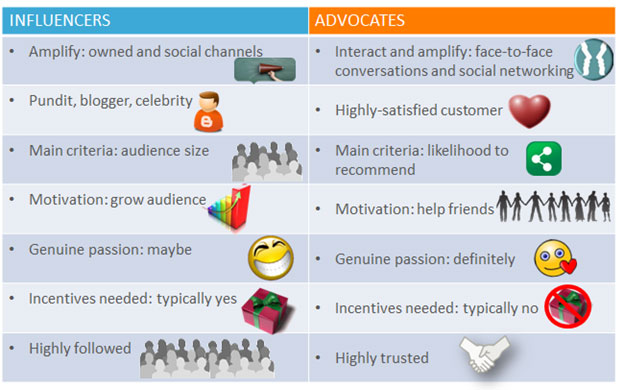 Here’s my marketing discipline rule of thumb: you know it’s a trend when there are more platforms to support it than there are bodies on Jones Beach on a 90’ summer day. And, once there’s a platform, scale is not far behind.
Here’s my marketing discipline rule of thumb: you know it’s a trend when there are more platforms to support it than there are bodies on Jones Beach on a 90’ summer day. And, once there’s a platform, scale is not far behind.
Let’s apply this rule of thumb to influencer marketing, which is having a moment. As the impact of PPC and other paid marketing models continues to diminish, brands are turning to opinion leaders to deliver their messages. Why? Both consumers and business customers want to hear stories from people who have deep authority and credibility discussing a specific topic or who are highly inspirational.
Where the waters muddy is when parsing the distinction between earned advocacy and paid influence. This chart highlights some distinct differences.

Influencers are a pathway to many eyeballs while advocates tend to bring fewer followers but a more authentic voice. Often brands tap both influencers and advocates. Many programs are launched by influencers in order to generate volume or attention and then are extended over the longer term through a company’s brand advocates.
Identification of influencers and advocates each has a distinct methodology and is dependent upon the role and mission of each group. Many platforms such as TapInfluence, CrowdTap, Group High, Expsoely, Fango and Speakr maintain databases of influencers across different categories and interests. Brands set the parameters of a campaign, identify and engage influencers for the program and manage it all from a single platform. Other brands use more manual methods to identify big name online influencers and work with them to execute programs against a defined creative brief. These initiatives more closely resemble celebrity endorsement programs.
For the most part, platforms focus on the consumer market and do not extend to influencers in the b2b space. B2B influencers typically are from the ranks of academia, government, management consultancies, media and business executives. Brands use many techniques to identify the right B2B influencers including listening, conference rosters, authorships, inclusion in white papers, round-tables and other thought leadership activities. Typically, mining inputs from multiple sources leads to the best group for a particular program.
Identifying advocates is also largely a manual process. Both B2B and B2C advocates typically represent the 6-8% of your customer base that is most passionate about your brand, products, services and programs. While fewer platforms exist for advocate program management, some like Zuberance and Crowdly specialize in advocate identification, activation and ongoing engagement. These platforms embed tools to find advocates but also allow brands to enter their own roster of advocates. Typically advocates are identified through listening, surveys, data mining, engagement history and hand-raising.
Many consumer brands tend to skew more towards the paid influencer side of the equation. B2B brands concentrate on customer reference programs and building content partnerships with industry influencers and the media as well as tapping key employee Subject Matter Experts (SMEs) to amplify thought leadership.
Here are some of the ways that brands engage with both influencers and advocates.
| Engagement | B2B | B2C |
| Content partnerships with industry or social influencers and celebrities | X | X |
| Co-creation of content with industry influencers, social influencers or celebrities | X | X |
| Ambassador: serving as the face of the brand in ads, media and at events | X | |
| Ambassador: serving as an unpaid spokesperson or representative in online communities, trade events, etc. | X | |
| Creative director | X | |
| CSR partnerships | X | X |
| Channel “take-over” | X | X |
| Product reviews or customer reference | X | X |
The bottomline is the inherent power in both influencer and advocate marketing to reach and persuade in a relatable, authentic and approachable way. Both have the ability to cause action and influence behavior.

Principal
Engaging your customers is at the heart of successful marketing programs. For more than 20 years, Cheryl has been building and executing content and thought leadership strategies designed to do just that. She is excited to be applying that well-honed skill to a help companies like Microsoft, Cisco, 3M, Intel, Capital One and Barclaycard tap into their stakeholder communities and build sophisticated content strategies.
Her experience base spans a range of industries – from technology and financial services to retail, travel, consumer products and healthcare. Cheryl has served as an integral member of her clients’ marketing teams, providing counsel on marketing and brand strategy, thought leadership, media relations, product introductions, and event management.
Prior to joining ComBlu, Cheryl spent 10 years leading corporate marketing for large, complex organizations.

Great article! Would like to speak with you more about influencers versus advocates, and when a combination approach works best, depending on brand objectives. ION (Influencer Orchestration Network) is developing a platform to identify advocates using psychometric data — predictive approach similar to eHarmony (to build long term advocate relationships with brands, versus quick flings a la Tinder).
Also liking your case studies a lot — would love to chat about Dell and Allstate in particular.